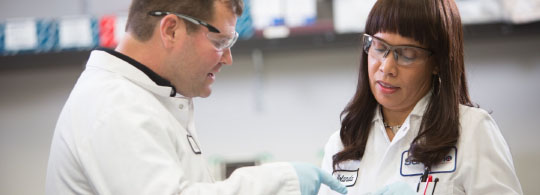Areas of Insight
Benefit vs. Risk

The next factor of the bioethics discussion is the risk-benefit assessment. This can be viewed as three main components: 1) a biopharmaceutical company deciding to develop treatments where it believes the burden of illness is significant and potential risks to the patient are worth taking; 2) a patient receiving transparent education and independently (in collaboration with a healthcare professional) deciding to consent to the potential risk, and 3) regulatory agencies making an informed judgment as to whether the benefits (with their uncertainties) of the drug outweigh the risks.
Research and Development
At Sangamo, the diseases we are working to treat have lifelong impact on the person with the condition, and those around them.
The more we understand what is most important to people with rare diseases, their families, and caregivers, the better we can address their needs. As a company, we must be mindful of how the potential risks and possible benefits of an experimental treatment might extend beyond the immediate measures of the condition itself.
The future of genomic therapies holds great promise in treating certain diseases such as hemophilia, sickle cell disease, neurodegenerative diseases, and leukemia, among others. These therapies could offer a better quality of life for patients with serious and potentially fatal conditions.
With all emerging research, we must be transparent about the uncertainty associated with treatment such as unwanted immune system reaction, infection, or other serious risks. Genomic medicine patients contribute to the advancement of research, but often with the selfless goal of supporting new scientific understanding that could bring relief to others who live with the same rare condition. As part of the benefit and risk discussion, our ethical bar is set higher. We must be transparent that they are among the first to test a therapy, and there is no guarantee of benefit for those who choose to participate.
Informed Patients
A continuance of the patient informed consent process is ensuring a meaningful conversation around the benefit and risk of participating in clinical trial or receiving a genomic medicine. Today’s genomic medicine patients are pioneers – the first to receive these treatments. By definition, medical science doesn’t have data on the lasting effects because no patient has lived a lifetime (yet) after receiving a genomic therapy.
Until longer-term medical monitoring data is available, these therapies should only be used for conditions with a compelling benefit versus risk for patients. Because there is no guarantee that a new drug in development will benefit a study participant, we must be sure that we never take a patient away from a proven treatment that could address their needs.
Ultimately, treatment decisions should be shared between a patient and health care provider to determine, with full understanding and transparency, whether the benefits of a genomic therapy outweighs the risk or burden of continuing with traditional treatments or letting the disease progress.
Regulatory Considerations
Benefit-risk assessment takes into account the extensive evidence of safety and effectiveness submitted by a sponsor in a marketing application (e.g. Biologics License Application (BLA), as well as many other factors, including the nature and severity of the condition the drug is intended to treat or prevent, the benefits and risks of other available therapies for the condition, and any risk management tools that might be necessary to ensure that the benefits of the drug outweigh its risks.
As genomic therapy research advances, the FDA has gone to great lengths to evaluate data across studies and pharmaceutical companies to improve the understanding of benefit-risk in cell and gene therapy and provide updated guidance for this field of study.
In 2021, the 70th Meeting of the FDA’s Cellular, Tissue, and Gene Therapies Advisory Committee5 convened to discuss the safety and toxicity risks of adeno-associated virus (AAV) vector-based gene therapy products. The Committee discussed ways to finetune both preclinical and clinical gene therapy research for the benefit of patient safety.
Additionally, the FDA is in the process of updating its Benefit-Risk Assessment for New Drug and Biological Products.6 This guidance is intended to clarify for drug sponsors and other stakeholders how considerations about a drug’s benefits, risks, and risk management options factor into FDA decision-making, among other considerations related to benefit-risk.
One of the greatest bioethical opportunities is finding a new way to evaluate benefit-risk for a treatment that is expected to have long-lasting effects. We will continue to partner with the FDA and all stakeholders to put patient safety first as this new field of medicine develops.

For the genomic medicines we are developing at Sangamo, the challenge is understanding the lifetime risk for a small group of vulnerable patients. The clinical trials we consent patients into are, by definition, first-of-their-kind. Gene therapy technologies have been studied during the past 30 years, but only recently are the next generation forms of genomic medicine being tested in the clinic. We don’t yet know the lifelong effects of a therapeutic we hope addresses the disease at its source. This is why we focus on serious medical conditions where we have the potential to make a real difference to patients’ lives, and where the potential benefit significantly outweighs the risk.
— Sandy Macrae, MRCP, PhD
CEO, Sangamo Therapeutics
A Patient’s Perspective:
Fabry Disease
Fabry disease, a rare genetic disorder, can be challenging to manage in everyday life. It is often described as an invisible disease; a person with Fabry often looks and acts normal until they cannot.
Four members of a single family lived years with Fabry symptoms: mysterious, painful, and unresolved. The path to diagnosis was long and frustrating, with family members living with symptoms including debilitating pain in the hands and feet, and gastrointestinal issues.
One family member experienced kidney failure that resulted in a kidney transplant, even though they were receiving Enzyme Replacement Therapy, an approved treatment for Fabry.
Enzyme Replacement Therapy is the most common treatment for Fabry disease. As frequently as twice per month, family members visit an infusion clinic to receive ongoing treatment.
Today, the family is on a mission to let others know a rare disease can and will attack from the inside. It may not be visible, but it is powerful.

Download White Paper